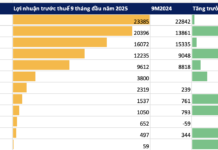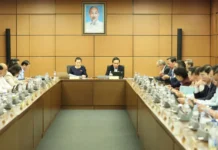Ninh Thuan was chosen after meeting stringent criteria
On November 25, 2009, the National Assembly issued Resolution No. 41/2009/NQ-QH12 on the investment policy for the Ninh Thuan Nuclear Power Project.
However, at the second session of the 14th National Assembly, Resolution No. 31/2016/QH14 was issued on halting the implementation of the policy on investing in the Ninh Thuan Nuclear Power Project, which took effect on November 22, 2016.
Now, the feasibility of restarting the nuclear power project is being considered. The draft amended Law on Electricity has also just updated the orientation of developing nuclear power.

Nuclear power is a source of electricity with low greenhouse gas emissions. Photo illustration: Chip Somodevilla | Getty Images
|
At this point, the location for the nuclear power plant is also mentioned. Previously, Ninh Thuan was chosen as the site for two nuclear power plants.
The planned construction sites for the Ninh Thuan 1 and 2 Nuclear Power Plants have undergone a lengthy research and selection process, meeting stringent international criteria. The report on the implementation of the National Assembly’s Resolution No. 31/2016/QH14 on halting the investment policy for the Ninh Thuan Nuclear Power Project in the 2016-2021 period, prepared by the National Assembly’s Economic Committee in 2022, clearly mentioned this rigorous selection process.
According to the International Atomic Energy Agency (IAEA), the process of selecting a site for a nuclear power plant consists of the following three stages:
Stage 1 – Site search and exploration
Stage 2 – Site evaluation
Stage 3 – Supplemental research before and after operation.
Stage 1, the site search and exploration process, consists of three phases: Phase 1 – Regional analysis and selection of potential sites (implemented during the 1996-2000 period); Phase 2 – Screening of potential sites and selection of candidate sites; Phase 3 – Comparison and prioritization of candidate sites (implemented during the 2001-2007 period).
Many stringent IAEA criteria such as power supply range; electrical system for construction; cooling water source; supplementary freshwater source; construction land; fault; earthquake; volcano; tornado; tsunami; flood; predominant wind direction; transportation system; distance to airport; distance to military area, chemical warehouse; resettlement compensation; soil type and local support…
To carry out the site evaluation, two partners, the E4 – KIEP – EPT consultancy consortium and JAPC consultancy, carried out activities over many years. Results: Phase 1 identified 20 potential sites in 11 provinces.
After comparison, evaluation and ranking, 10 sites in 7 provinces were selected. Finally, 8 sites in 6 provinces were selected (according to Decision No. 906/QD-TTg dated June 17, 2010 of the Prime Minister approving the orientation of planning the development of nuclear power in Vietnam by 2030).
Vinh Truong village, Phuoc Dinh commune, Thuan Nam district and Thai An village, Vinh Hai commune, Ninh Hai district of Ninh Thuan province have been studied and carefully surveyed by relevant units and foreign partners for a long time and meet the strict requirements of the IAEA.
Site selection is also very expensive. From 2010 to 2015, the cost of carrying out the feasibility study and site evaluation for each location was more than 30 million USD, provided by the governments of the Russian Federation and Japan to Vietnam in the form of non-refundable aid.
In the period 2011-2015, the work related to the site began to move to Stage 2 – Site evaluation stage; Vietnam Electricity Group signed contracts with partners, the E4 – KIEP – EPT consultancy consortium (Russian Federation) and Japan Atomic Power Company (JAPC) to implement the preparation of the Site Approval Document (SAD) and the Investment Project (FS) for Ninh Thuan 1 and Ninh Thuan 2 Nuclear Power Projects. The contract value is also from non-refundable aid.
According to Report No. 80/BC-UBND dated April 1, 2022 of the People’s Committee of Ninh Thuan province, the total planned area for the construction of the Ninh Thuan Nuclear Power Plants is 1,642.22 ha (over 90% of which is agricultural land), with a population of 3,717 people/1,063 households in the construction area.
What are these sites like after the suspension of the nuclear power development policy?
According to the monitoring report, in order to implement Resolution No. 31/2016/QH14, the Government has adjusted the planning and land use plan up to 2020 (Resolution 113/NQ-CP dated August 30, 2018) for the area of Ninh Thuan 1 Nuclear Power Plant to plan for renewable energy development; the area of Ninh Thuan 2 Nuclear Power Plant keeps the current land use purpose. Up to now, the planning of the location for the construction of Ninh Thuan nuclear power plant according to the decisions of the Ministry of Industry and Trade is still valid.
“It is necessary to determine that the cancellation of the decisions related to the approval of the construction sites of Ninh Thuan 1 and 2 Nuclear Power Projects will be understood by partners and domestic public opinion as a complete termination of the nuclear power development program in Ninh Thuan, while these sites are assessed as potential and safe, have been carefully studied, and it is difficult to find alternative sites,” the monitoring report noted.
The National Assembly’s Economic Committee at that time proposed that the Government consider temporarily retaining the planning for the locations expected to build Ninh Thuan 1 and 2 Nuclear Power Plants until the competent authority makes an official decision on this issue.
|
In this monitoring report, the National Assembly’s Economic Committee stated: “Nuclear power is a source of electricity with low greenhouse gas emissions and will make an important contribution to climate change mitigation. Developing nuclear power is an important solution to ensure national energy security, security for the power system with diverse sources of electricity and especially to ensure the base source for renewable energy sources, which have been booming in the past time.” Therefore, the Economic Committee believes that in order to ensure national energy security and the country’s independent and self-reliant economic development, ensure security for the power system with diverse sources of electricity, especially to ensure the base source for renewable energy sources, which have been booming recently, according to the roadmap to reduce emissions towards net zero emissions by 2050, nuclear power is an issue that needs to be studied and considered in the process of developing the energy industry in the next stage. |
Luong Bang
The Capital-Raising Enterprise: How TTC Group Masters the Art of Bond Issuance
“The investment arm of TTC Group, TTC Investment, has successfully raised 2,000 billion VND through a bond issuance. This successful fundraising effort underscores TTC Investment’s strong standing in the market and the confidence that investors have in the group’s prospects.”











































